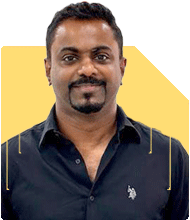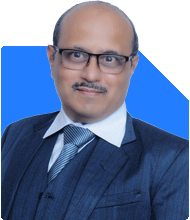Ramalingam Kalirajan |10881 Answers |Ask -Follow
Mutual Funds, Financial Planning Expert - Answered on Jul 11, 2024
He has an MBA in finance from the University of Madras and is a certified financial planner.
He is the director and chief financial planner at Holistic Investment, a Chennai-based firm that offers financial planning and wealth management advice.... more

Dear sir, My husband retaired from tyre factory He earned 1 Lack permonthly. We spend money for children education and we bought one house. Now my husband pension just 4000 and my salary 50k only. My two son are studying. How i will manage current economic situation. After retairement at the age 60 what job he can do? Please give suggestion.we have house loan 20L
Evaluate Current Financial Status
Your monthly income is Rs. 54,000. This includes your husband’s pension and your salary. Your biggest challenge is managing expenses and planning for the future.
Expenses:
Children’s education
Household expenses
House loan EMI
Create a Detailed Budget
Make a budget to track income and expenses. It will help in understanding where your money goes and where you can save. List all fixed and variable expenses.
Fixed Expenses:
House loan EMI
Children’s school fees
Variable Expenses:
Groceries
Utilities
Transportation
Cut Unnecessary Expenses
Identify non-essential expenses and reduce them. This could include dining out, entertainment, or other luxuries. Every rupee saved can help in managing your budget better.
Increase Your Income
Your husband can take up a part-time job or freelance work. This can be a great way to supplement your income. Here are some job ideas for him:
Consulting: If he has expertise in his field, consulting can be lucrative.
Tutoring: Teaching school subjects or specific skills.
Freelance Work: Writing, graphic design, or any skill he possesses.
Online Jobs: Data entry, customer support, or virtual assistance.
Leverage Your Assets
You own a house. If you have an extra room, consider renting it out. This can provide a steady source of income.
Focus on Debt Repayment
Pay off your house loan as quickly as possible. This will reduce your financial burden and free up money for other needs. Prioritize high-interest debts first.
Build an Emergency Fund
Set aside money for emergencies. This fund will protect you from unexpected expenses. Aim for at least six months’ worth of expenses.
Invest in Mutual Funds
Mutual funds are a great way to grow your money. They offer various benefits:
Diversification: Spread your investment across various assets.
Professional Management: Managed by experts to maximize returns.
Flexibility: Start with a small amount and increase over time.
Types of Mutual Funds
Equity Funds: Invest in stocks. High risk, high returns.
Debt Funds: Invest in bonds. Lower risk, stable returns.
Balanced Funds: Mix of equity and debt. Moderate risk and returns.
Power of Compounding
Mutual funds benefit from compounding. This means your returns earn more returns over time. Start investing early and regularly for maximum benefit.
Risks of Mutual Funds
Market Risk: The value of investments can fluctuate.
Interest Rate Risk: Changes in interest rates can affect returns.
Credit Risk: Risk of default by bond issuers.
Benefits of Actively Managed Funds
Actively managed funds have professionals making investment decisions. They aim to outperform the market. This can lead to higher returns compared to index funds, which simply track the market.
Importance of Financial Planning
A Certified Financial Planner (CFP) can help you create a financial plan. They can guide you on investments, insurance, and retirement planning.
Retirement Planning
Plan for your retirement to ensure financial security. This includes:
Retirement Savings: Invest in mutual funds, NPS, or other schemes.
Health Insurance: Ensure adequate coverage for medical expenses.
Pension Plans: Explore plans that provide regular income post-retirement.
Children’s Education Fund
Education costs are rising. Start an education fund for your children. Invest in child-specific plans or mutual funds to grow this fund over time.
Insurance Coverage
Ensure you have adequate life and health insurance. This protects your family in case of emergencies.
Avoid Real Estate Investments
Real estate can be risky and illiquid. Focus on investments that offer better liquidity and diversification, like mutual funds.
Surrendering Investment-cum-Insurance Policies
If you hold LIC, ULIP, or other investment-cum-insurance policies, consider surrendering them. Reinvest the proceeds in mutual funds for better returns.
Final Insights
Managing finances post-retirement can be challenging. With careful planning and disciplined saving, you can secure your future. Prioritize budgeting, cutting unnecessary expenses, and increasing your income. Invest in mutual funds to grow your wealth. Consider seeking advice from a Certified Financial Planner for personalized guidance.
You’re doing a great job managing your family’s finances during a tough time. Your dedication to your children’s education and securing a home is commendable. Keep up the good work, and with a bit of planning, you’ll navigate these challenges successfully.
Best Regards,
K. Ramalingam, MBA, CFP
Chief Financial Planner,
www.holisticinvestment.in
You may like to see similar questions and answers below
Ramalingam Kalirajan |10881 Answers |Ask -Follow
Mutual Funds, Financial Planning Expert - Answered on Jul 24, 2024
Ramalingam Kalirajan |10881 Answers |Ask -Follow
Mutual Funds, Financial Planning Expert - Answered on Sep 02, 2024
Rajesh Nair | Answer |Ask -Follow
Hiring, Leadership Expert - Answered on Aug 02, 2024
Nitin Narkhede | Answer |Ask -Follow
MF, PF Expert - Answered on Oct 25, 2024
Nayagam P P |10854 Answers |Ask -Follow
Career Counsellor - Answered on Dec 14, 2025
Radheshyam Zanwar |6744 Answers |Ask -Follow
MHT-CET, IIT-JEE, NEET-UG Expert - Answered on Dec 14, 2025
Radheshyam Zanwar |6744 Answers |Ask -Follow
MHT-CET, IIT-JEE, NEET-UG Expert - Answered on Dec 14, 2025
Dr Dipankar Dutta |1840 Answers |Ask -Follow
Tech Careers and Skill Development Expert - Answered on Dec 14, 2025
Dr Dipankar Dutta |1840 Answers |Ask -Follow
Tech Careers and Skill Development Expert - Answered on Dec 13, 2025
Dr Dipankar Dutta |1840 Answers |Ask -Follow
Tech Careers and Skill Development Expert - Answered on Dec 13, 2025
Mayank Chandel |2575 Answers |Ask -Follow
IIT-JEE, NEET-UG, SAT, CLAT, CA, CS Exam Expert - Answered on Dec 13, 2025
Radheshyam Zanwar |6744 Answers |Ask -Follow
MHT-CET, IIT-JEE, NEET-UG Expert - Answered on Dec 13, 2025
Mayank Chandel |2575 Answers |Ask -Follow
IIT-JEE, NEET-UG, SAT, CLAT, CA, CS Exam Expert - Answered on Dec 13, 2025
Mayank Chandel |2575 Answers |Ask -Follow
IIT-JEE, NEET-UG, SAT, CLAT, CA, CS Exam Expert - Answered on Dec 13, 2025























